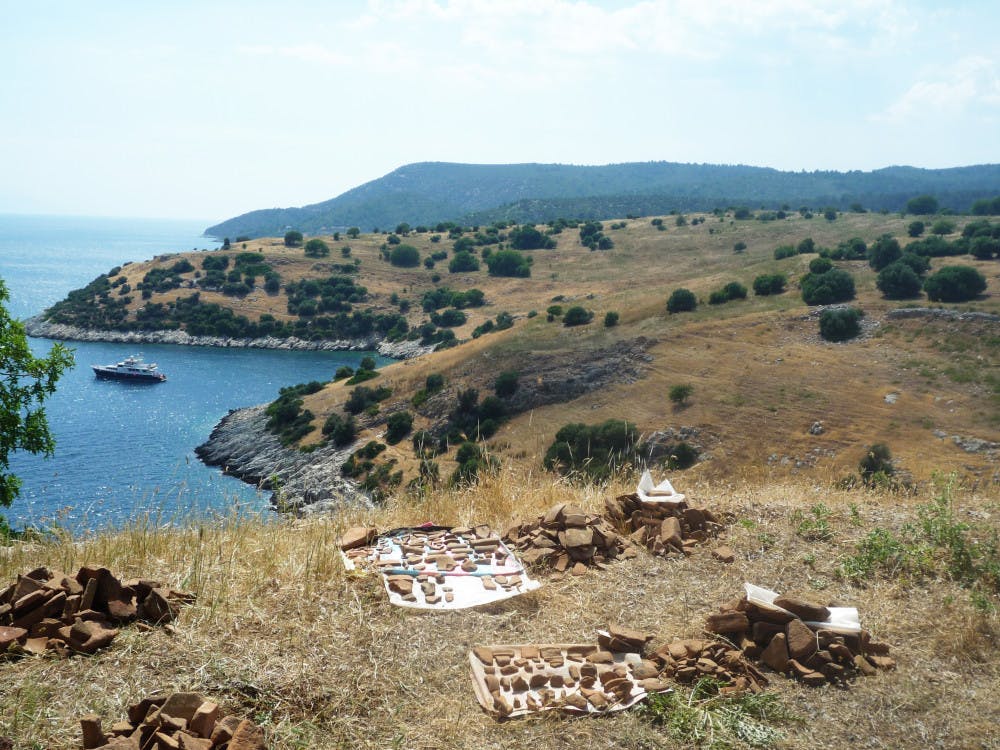As archaeology and anthropology undergraduates, graduate students and faculty members transition back to life on College Hill, the start of the semester marks a hiatus from their fieldwork undertaken around the globe this summer.
The Department of Anthropology sent people to 14 countries, including Brazil, England, India and China, while the Joukowsky Institute for Archaeology and the Ancient World sent about 30 students to 10 countries to work on 15 different projects, according to departmental estimates.
“Almost everyone (at the institute) was away doing fieldwork,” said Catie Stiedl GS, a 4th-year PhD student at the Joukowsky Institute. Stiedl worked on two projects over the summer. She first flew to Turkey to assist Felipe Rojas, assistant professor of archaeology and the ancient world and of Egyptology and Assyriology, with the Notion Archaeological Survey. She spent four weeks analyzing ceramics and identifying and measuring stone quarries. Stiedl then flew to Greece to work on the Mazi Archaeological Project — commonly referred to as MAP — to catalog pottery in the region.
“The Notion project is strongly tied to my own dissertation research,” Stiedl said. “I’m thinking about the questions I’m asking in my research and looking at how they relate to research questions in the (Notion) project.”
Second year anthropology Ph.D. student Alice Larotonda GS spent the summer doing fieldwork and exploring potential dissertation topics. She stayed in Cape Verde for eight weeks, speaking to caretakers of young children — mainly mothers and grandmothers — to learn about their experiences raising children as well as the challenges they face.
“I was working on defining what I wanted to do and what was relevant for the population there,” Larotonda said, adding that she had to start everything from scratch but greatly benefited from contacts she made through members of the Cape Verdean community in Rhode Island. “There’s a large Cape Verdean community here in Providence,” Larotonda said. “I’m happy to be doing something that can be useful to the local community, too.”
John Cherry, professor of archaeology, classics and anthropology, along with his team, spent five and a half weeks in the West Indies for the Survey and Landscape Archaeology on Montserrat project’s sixth season. Due to an active volcano on Montserrat, 60 percent of the island is too dangerous to venture into, Cherry said. To overcome the obstacle of not being able to travel to many of the archaeological sites in person, the project teamed up with the Montserrat Volcano Observatory to gather data using a new imaging technology known as LiDAR — Light Detection and Ranging — which had never been used before in the Caribbean.
Using this technology, the team worked with 3-D point cloud data to identify structures of interest, such as windmills, on the island. After combing through the data, small teams of students armed with machetes and a handheld GPS device set off to find the structures located throughout the island.
“You have to literally chop your way through the thick jungle,” Cherry said, adding that additional problems arose because the LiDAR imagery was sometimes misleading. Cherry said he hopes this summer’s methodological findings will be of use to the wider discipline of archaeology.
Many of the teams in the field this summer were composed not only of Brown students and faculty, but also of researchers from around the world. “You’ll hear three, four, five languages being spoken at the same time,” said Professor of Archaeology and Anthropology Peter Van Dommelen, who helped lead a team of researchers in excavating a nuraghe, or stone tower, in Sardinia for six weeks this summer. The experience of fieldwork and this intersection of languages “broadens people’s minds,” he added.
Assistant Professor of Anthropology Parker VanValkenburgh led a team of 20 archaeologists and 20 local workers in Zana, Peru. The team aimed to gain a better understanding of the impact of Spanish colonialism on the region’s indigenous people. “One of the most important aspects of archaeology is the implications for social justice. History is never written about these people,” VanValkenburgh said.
This summer marked the third major field season for the project, and a large chunk of the analysis from the last two seasons had been left untouched. Kristina Lee ’16 analyzed that material over the summer, starting with six boxes of skeletal remains. “I got to work with an actual skeletal population, which was not something I had foreseen,” Lee said.
Though much of her summer was spent in a lab, Lee was also able to visit the site and help out in the field. She was also able to spend time with locals, which she said let her connect the work she was doing to those who actually lived there.
During the summer, those in the field can focus solely on their projects, Cherry said, adding that they cannot maintain that same intensity during the school year. But despite the physical distance from the work, team members continue to stay in touch from afar, multiple sources said.
“The best thing about archaeology is the great people,” VanValkenburgh said. “The work that one does is only as good as the people that you work with.”





